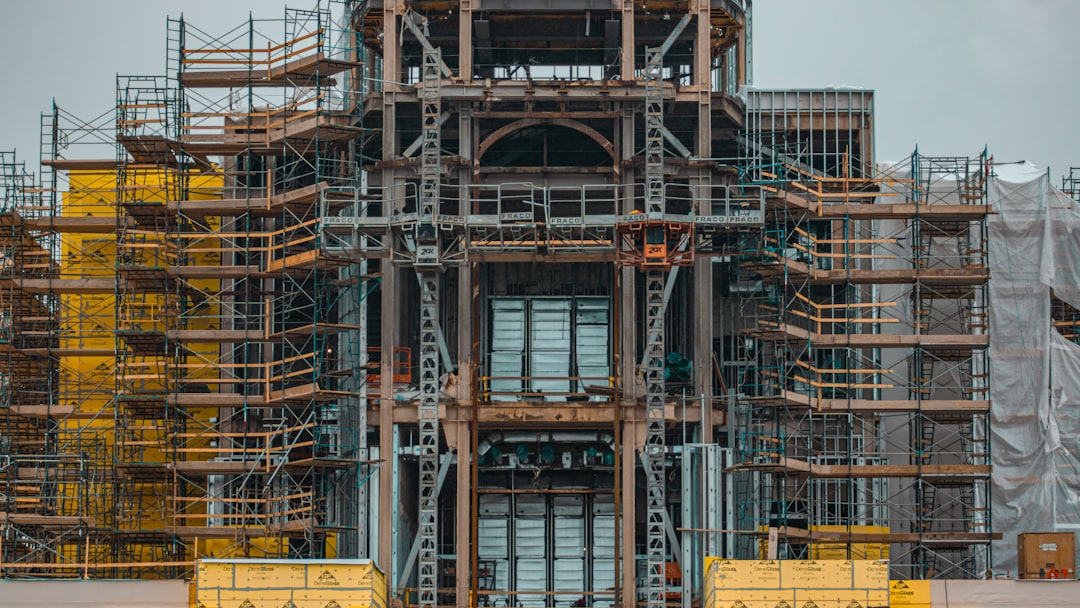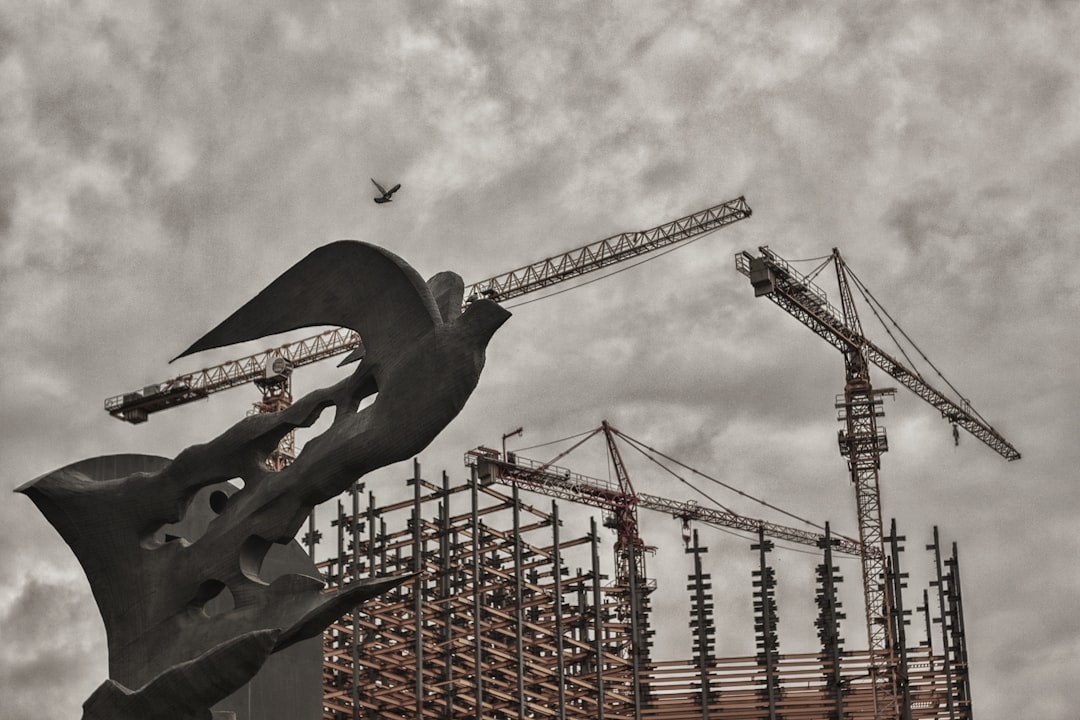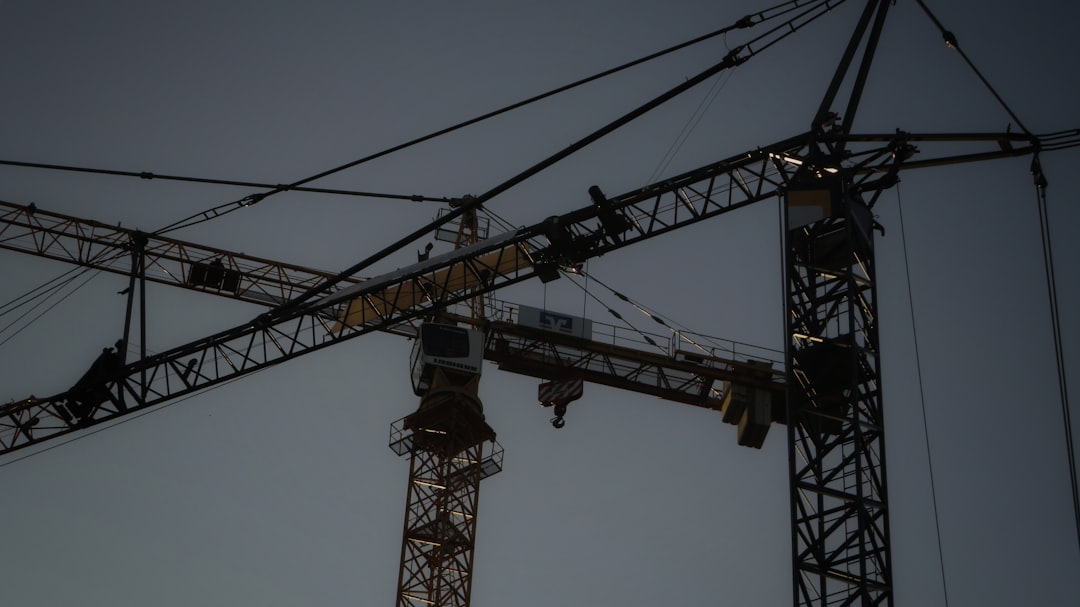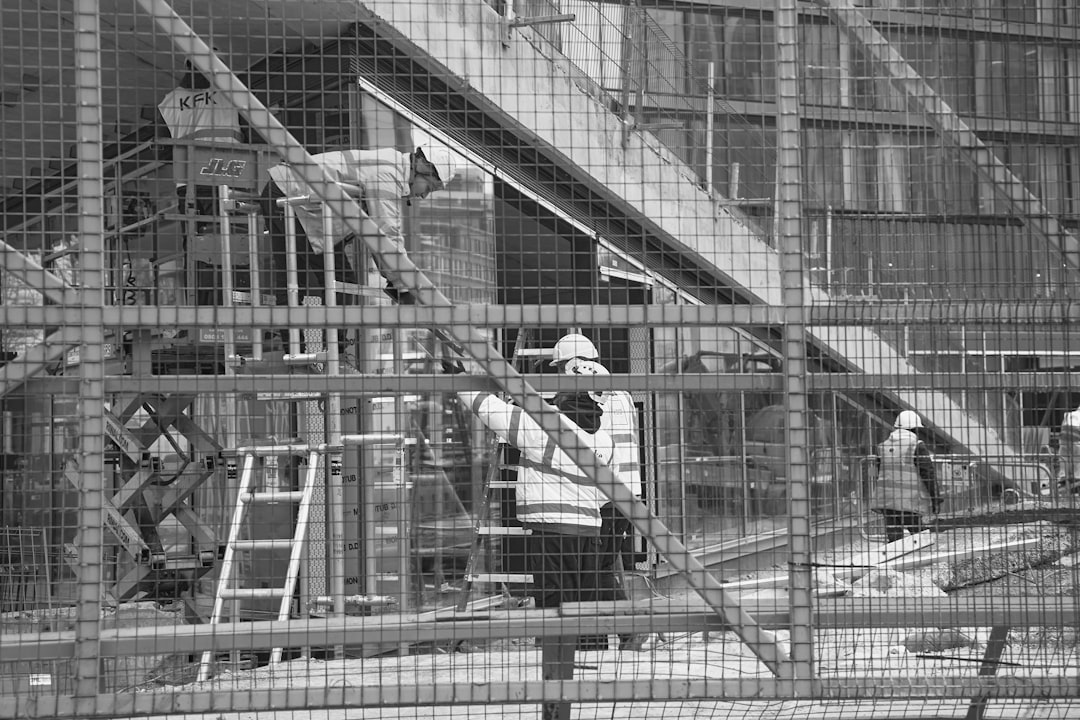

Engage prospects with a scan and streamline customer engagement with FREE QR code marketing tools by Sona – no strings attached!
Create a Free QR CodeFree consultation

No commitment

Engage prospects with a scan and streamline customer engagement with FREE QR code marketing tools by Sona – no strings attached!
Create a Free QR CodeFree consultation

No commitment
In today's digitally driven world, QR codes are transforming how metal building contractors connect physical job sites, print assets, and project handoffs with digital tools, real-time updates, and client engagement. For commercial and residential metal building construction companies, QR codes present a frictionless bridge between traditional workflows and modern customer expectations, enabling instant access to documentation, progress tracking, compliance information, and post-construction support. This approach helps project teams, suppliers, and clients interact more efficiently without the need for complex apps or additional hardware.
For metal building contractors, QR codes can streamline everything from viewing building designs and accessing maintenance guides to submitting RFQs or verifying contractor credentials. Yet, a persistent frustration remains: missing out on high-value prospects or project-critical updates simply because essential data falls through the cracks in analog or disconnected workflows. By embedding dynamic, trackable QR codes on construction signage, project materials, and marketing collateral, contractors not only enable seamless handoffs but also close visibility gaps that can lead to lost opportunities, incomplete handovers, or compliance risks. These codes foster transparency and empower both field and office personnel to access and contribute relevant information instantly.
This guide reveals how QR codes can be strategically deployed to eliminate paper-driven bottlenecks, connect previously anonymous or hard-to-track interactions to actionable business intelligence, and unlock measurable business results in the metal building construction industry.

QR codes bridge the gap between physical touchpoints and digital outcomes, allowing metal building contractors to provide clients, subcontractors, and facility managers with instant digital access to building documentation, maintenance schedules, and project updates. Paper-based systems often lead to outdated information, missing forms, and version control headaches, which can delay work and erode trust on site.
A structured rollout makes it simple to replace manual and analog tasks with fast, measurable digital interactions. The goal is to map QR codes to your most common friction points, then standardize how your team designs, deploys, and tracks each code. Use a single platform like Sona QR to centralize management, update destinations after printing, and analyze performance across placements and projects.
Modern QR tools replace error-prone, paper-based processes and connect every interaction to digital workflows. By standardizing on a platform like Sona QR, you gain control over versioning, branding, and analytics, all while making it easier for field teams to access what they need.
Example: Replace the printed project binder at a job site with QR codes on signage that link to digital schedules, site safety checklists, and equipment manuals. This ensures the latest version is always accessible, helps avoid the risk of crews referencing outdated procedures, and creates a clear trail of engagement for future maintenance or compliance reviews.
Metal building contractors move information among field crews, office staff, suppliers, and clients while juggling safety and compliance. That constant exchange often relies on paper, ad hoc emails, and phone calls, which makes it easy to miss document updates or lose track of who received what. Even small errors, like referencing the wrong drawing or overlooking a new safety bulletin, can cause rework, delays, or compliance risk.
QR codes introduce speed, accuracy, and traceability to everyday tasks. Instead of guessing whether a subcontractor has the latest spec or hunting through email chains for a warranty record, any stakeholder can scan and retrieve the correct resource instantly. Teams can also see which assets are being accessed, learn from engagement patterns, and iterate quickly without reprinting materials.
When QR code programs are deployed deliberately, even small changes can yield significant improvements in team efficiency, customer transparency, and campaign ROI. Over time, scan data becomes a strategic asset that reveals which messages and placements reduce friction across the project lifecycle.

Metal building contractors benefit most when QR codes are selected and configured to match the task. Formats should align with the action you want the end user to take and the environment in which the scan happens. For instance, a code on a safety board serves a different purpose and audience than a code on a trade show brochure.
Dynamic codes are the default for most contractor workflows, since projects change constantly and multiple teams need to stay aligned. Static codes can still be useful for evergreen assets, but they limit tracking and make updates costly after printing. Sona QR supports both, while keeping code management, branding, and analytics in one dashboard.
Dynamic QR codes are particularly effective because they allow companies to keep information current across every touchpoint without reprinting or losing track of which version is live. This matters when managing dozens of projects, hundreds of codes, and multiple stakeholder groups who depend on accurate information.

Growth often stalls when high-value offline interactions are not captured. Job site visitors, walk-up inquiries, and trade show conversations may generate interest, yet without a smooth offline to online handoff, those moments never make it into your CRM. QR codes can turn these physical touchpoints into trackable digital journeys that power future marketing, sales, and service.
Identify placements where information is already sought, then connect that intent to a relevant, high-value action. Make scanning the easiest way to see designs, request quotes, or access compliance materials. Reinforce scanning with concise copy, bold framing, and benefit-first messaging so users know exactly what they get. For broader strategy, explore metal building marketing.
By focusing on these intersections where physical and digital workflows meet, metal building contractors can ensure no high-fit account, prospect inquiry, or field issue goes undetected. Over time, these placements compound into a measurable pipeline of engaged contacts and repeat service opportunities.

QR codes work best when anchored to the real decisions and tasks your teams and clients face every day. Start with the use cases that reduce the most friction or create the clearest revenue impact, then expand into supportive or specialized workflows as adoption grows.
For many metal building contractors, the highest-return applications center on documentation access, lead capture, and post-install service. Each use case converts a familiar offline moment into a digital path that is faster for the user and more measurable for the business.
These use cases do more than simplify workflows. They create a shared source of truth for teams and clients, enhance trust by keeping content current, and generate the analytics needed to improve every future project.
When a scan occurs, it signals intent in context. A superintendent scanning a safety checklist has different needs than a building owner scanning a warranty sticker, and both differ from a prospect scanning a pricing sheet. With the right tagging and routing, each scan can automatically feed the correct audience and trigger the next best action. For deeper strategy, see Sona’s blog, the Essential Guide to Intent Data.
Start by deploying unique QR codes across journey stages and physical locations, then use your QR platform to tag each code by use case, channel, and placement. This creates clean segments that reflect real behavior rather than guesswork. Tools like Sona QR can sync these segments to your CRM and advertising platforms so you can retarget with precision.
With Sona QR, each code becomes a smart entry point into your funnel. You capture the who, where, and why of engagement, then retarget based on real behavior, like following up a pricing sheet scan with a cost breakdown email or prompting a safety checklist scanner to subscribe to weekly site updates.
In many contracting businesses, print, site, and event investments are managed separately from digital channels. QR codes unify these efforts by turning every physical asset into a measurable onramp to your digital experiences. That improves attribution, eliminates dead ends, and gives teams the data needed to allocate spend wisely.
To maximize value, standardize how you create, brand, and measure codes across channels. Use unique codes per placement so you can compare performance, then bring all scan activity into a central dashboard for cross-channel analytics. Align each destination to the stage of the buyer journey or project phase for consistency and clarity.
By bringing all QR activity into one platform like Sona QR, leaders see which messages and placements accelerate deals, which reduce support load, and where to increase investment. This connected approach replaces disconnected tactics with a measurable, end-to-end funnel.
A disciplined rollout turns QR codes from a one-off experiment into a repeatable growth lever. Use this checklist to plan, execute, and optimize your campaigns in a way that aligns field operations with marketing and client services. Begin with one priority use case, then expand once you validate adoption and impact.
Build each campaign with a clear owner, timeline, and success metric. Coordinate with field teams to validate placements and scanning conditions, and ensure your analytics and CRM integrations are configured before launch so you do not lose attribution.
Start by defining a single, high-impact objective. For example, digitize project documentation at job sites to reduce lost paperwork, improve version control, and speed up inspections. If demand generation is the priority, choose event lead capture with RFQ forms that sync directly to your CRM.
Validate the use case with the end users who will scan the code. Confirm what they need, when they need it, and what would make scanning clearly valuable. This early alignment drives adoption and reduces the need for rework.
Choose dynamic codes for any campaign that requires updates, tracking, or segmentation. Dynamic codes let you change destinations after printing, attach UTM parameters, and view scan analytics by placement or device. Static codes are appropriate for truly evergreen content that will never change. You can create and manage both using Sona QR.
Map the code type to your environment. On a construction fence, you likely want a dynamic code tied to a mobile-friendly resource hub. On an internal-only Wi-Fi placard inside a trailer, a static code could suffice, although dynamic still adds flexibility if credentials change.
Design with scannability first. Use high contrast, place codes against flat surfaces, and avoid glossy lamination that can glare in sunlight. Add your logo and a clear border or frame to draw attention. Above all, write a benefit-led call to action that spells out the value, such as Scan for Current Drawings or Scan to Request a Quote.
Test across real conditions before you print at scale. Check common phones and camera apps, verify distance and angle usability, and test at different times of day to account for lighting changes. Confirm that the landing experience is mobile optimized and that analytics and CRM tagging work correctly.
Roll out codes on signage, proposal packets, trade show banners, and equipment tags. Match placement to audience behavior, like placing documentation access codes near gates and entry points, or RFQ codes on the back cover of brochures that prospects take home.
Provide field teams with a quick reference guide and standard operating procedures that explain what each code does, how to encourage scanning, and who to contact if a destination needs updating. Train staff to promote the codes with a simple, benefit-first script.
Monitor performance in a centralized dashboard. Track scans by time, location, device, and campaign. Look for patterns, such as which placements drive repeat scans or which events generate the highest RFQ conversion rates. Evaluate conversion behavior and drop-off points on the landing pages.
Use the insights to refine messaging, reposition codes, or adjust the destination experience. A/B test calls to action, landing page layouts, or content hierarchy. Create follow-up workflows that trigger immediately after key scan events, such as sending updated drawings to a subscriber or notifying sales when a pricing sheet is scanned multiple times.
This structured approach replaces guesswork and bottlenecks, producing a measurable feedback loop between every scan and improved project delivery. Over time, your QR system becomes a living layer of your operations, sales, and client service processes.
Contractors often struggle to connect offline engagement to outcomes like RFQs, signed contracts, or service renewals. Without knowing who scanned, where, and why, you cannot attribute results or prioritize follow-up effectively. QR analytics change that by revealing which assets and placements drive meaningful actions across the buyer journey and project lifecycle. See Sona’s The Essential Guide to Offline Attribution for frameworks and examples.
Measuring beyond the scan is essential. You want to know how a scan influenced the next step in the journey, such as a form fill, a scheduling request, or a return visit to the proposal. With dynamic codes and a platform like Sona QR, you can carry campaign tags through to your CRM, unify identity across touches, and tie engagement to revenue. Sona is an AI-powered marketing platform that identifies visitors, enriches data, and unifies attribution with activation. Learn more at Sona. With Sona.com, you can also attribute revenue through identity resolution and Single vs Multi-Touch Attribution, unifying fragmented touchpoints across buying stages into a single buyer journey. The result is a performance marketing system that ties real-world scans to pipeline and closed revenue.
Use Sona QR and Sona.com to go further. You can track every scan with time, device, and location, measure engagement by channel and context, respond in real time with destination updates, and sync with your CRM to enrich contacts automatically. With Sona.com, you can also attribute revenue through identity resolution and multi-touch attribution, unifying fragmented touchpoints across buying stages into a single buyer journey. The result is a performance marketing system that ties real-world scans to pipeline and closed revenue.
QR success grows when codes become part of daily habits for your teams and easy win moments for your clients. Make the value clear, ensure the experience is fast on mobile devices, and keep destinations updated so users trust the scan every time. Training and reinforcement are as important as the technology itself.
Start with a handful of high-traffic placements, validate the experience, and expand based on evidence. Build internal champions who monitor performance and collaborate with operations, safety, and sales to keep the program aligned with real needs and targets.
As results accumulate, present wins to leadership with data and examples. Show where scanning reduced support tickets, accelerated approvals, or increased RFQs, then scale the program across more projects and placements.

The most effective QR deployments are simple to scan, valuable at the moment of need, and measurable. Contractors are using QR codes on fences, trailers, brochures, and installed equipment to make life easier for crews and clients while giving leaders better visibility into what works.
These examples illustrate how QR codes can unlock time savings, reduce friction, and improve client satisfaction without requiring a heavy investment in new apps or devices. Each example also produces data that guides future decisions about messaging and placement.
For each example, teams learned which calls to action and placements generated the highest engagement. Those insights informed broader rollouts and improved the consistency of client experiences.
To maximize scan rates and outcomes, meet people where they are, then make scanning the fastest path to value. Prioritize visibility, clarity, and mobile performance. Reinforce with training and simple scripts so staff confidently promote scanning without friction.
Common pitfalls include burying codes, using vague calls to action, failing to optimize landing pages for mobile, and letting destinations go stale. These mistakes undermine trust and reduce adoption, which leads teams to abandon QR codes before they see the full benefit.
Effective execution closes the gap between aspiration and impact, ensuring each QR initiative contributes to better project outcomes and stronger client relationships. The best programs pair thoughtful placements and content with analytics and training, then iterate based on what the data shows.
By addressing sources of missed opportunity, outdated account data, and fragmented tracking, QR codes are helping metal building contractors connect every physical site, asset, and interaction to the digital workflows that drive growth. Instead of losing high-value prospects or failing to surface key engagement signals, modern QR deployments empower teams to create measurable bridges between every job phase. When executed thoughtfully, with robust tracking and purposeful use cases, QR code strategies move organizations past the limits of paper and manual handoffs, driving real business impact from first scan through final delivery and ongoing service.
If you are ready to operationalize QR codes across your projects, consider standardizing on a platform like Sona QR. You can generate dynamic codes, update destinations after printing, monitor performance in real time, and sync scan activity to your CRM for clean attribution. Start creating QR codes for free.
QR codes have revolutionized the metal building contractors industry by transforming traditional access management into seamless, trackable interactions. Whether it’s enabling secure site access, streamlining equipment checkouts, or improving communication with clients and teams, QR codes replace cumbersome manual processes with instant, mobile-friendly solutions that boost efficiency and accountability. Imagine having real-time visibility into who accessed what, when, and where—empowering you to enhance site safety and project management effortlessly.
With Sona QR, you can create dynamic, trackable QR codes tailored for metal building projects that update instantly without the need to reprint signage or badges. Every scan feeds valuable data directly into your workflow, helping you optimize operations and deliver a superior client experience. Start for free with Sona QR today and turn every scan into a secure, actionable step that drives your metal building projects forward.
QR codes help metal building contractors streamline access to project documentation, improve version control, enable real-time updates, and enhance communication between field teams, office staff, suppliers, and clients without the need for apps or extra hardware.
Dynamic QR codes are most effective because they allow updating of destinations after printing, tracking of scans, and segmentation by use case, while static QR codes are suitable for evergreen content but limit updates and tracking.
Effective placements include job site signage, equipment stickers, project brochures, trade show materials, conference booths, and maintenance labels to connect physical touchpoints with digital resources and capture leads or service requests.
Contractors can use platforms like Sona QR to monitor scan volume, location, device type, and conversion outcomes, integrate scan data with CRMs for lead attribution, and analyze which assets or placements drive the most value.
They should define a clear use case, choose the appropriate QR code type, design and test codes for scannability, deploy codes across relevant channels, train teams to promote scanning, and continuously track and optimize performance.
QR codes provide instant access to up-to-date drawings, compliance documents, maintenance guides, and contact information, reducing miscommunication, speeding approvals, and enabling transparent, real-time information sharing.
Avoid placing codes in hard-to-scan locations, using vague calls to action, failing to optimize landing pages for mobile, and neglecting to update QR destinations regularly to maintain user trust and adoption.
By placing QR codes on brochures, banners, and displays that link to RFQ forms or pricing calculators, contractors can convert booth interest into qualified leads and trigger personalized follow-up sequences.
QR codes affixed to equipment or structural components link to warranty registration, service manuals, and support forms, reducing paperwork errors and facilitating timely maintenance and upsell opportunities.
By standardizing QR code creation and tracking across print collateral, direct mail, job site signage, and event materials, contractors unify offline and online campaigns to improve attribution, measure ROI, and optimize budget allocation.
Use Sona QR's trackable codes to improve customer acquisition and engagement today.
Create Your FREE Trackable QR Code in SecondsJoin results-focused teams combining Sona Platform automation with advanced Google Ads strategies to scale lead generation

Connect your existing CRM

Free Account Enrichment

No setup fees
No commitment required

Free consultation

Get a custom Google Ads roadmap for your business






Launch campaigns that generate qualified leads in 30 days or less.
